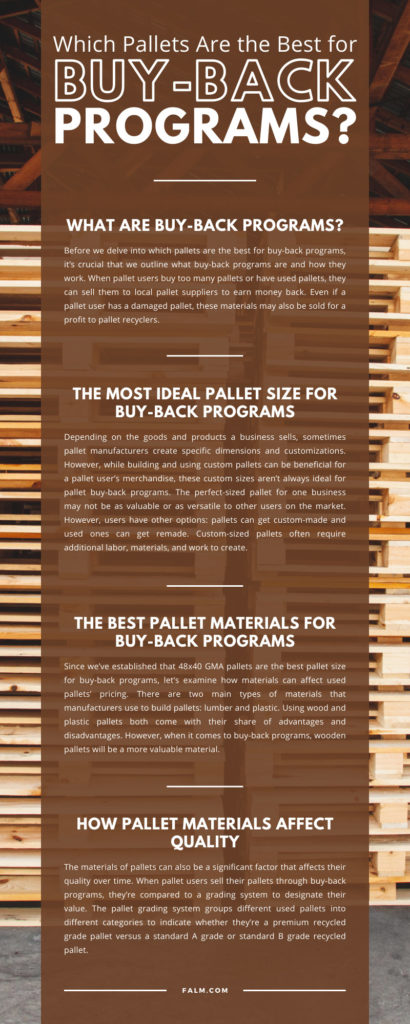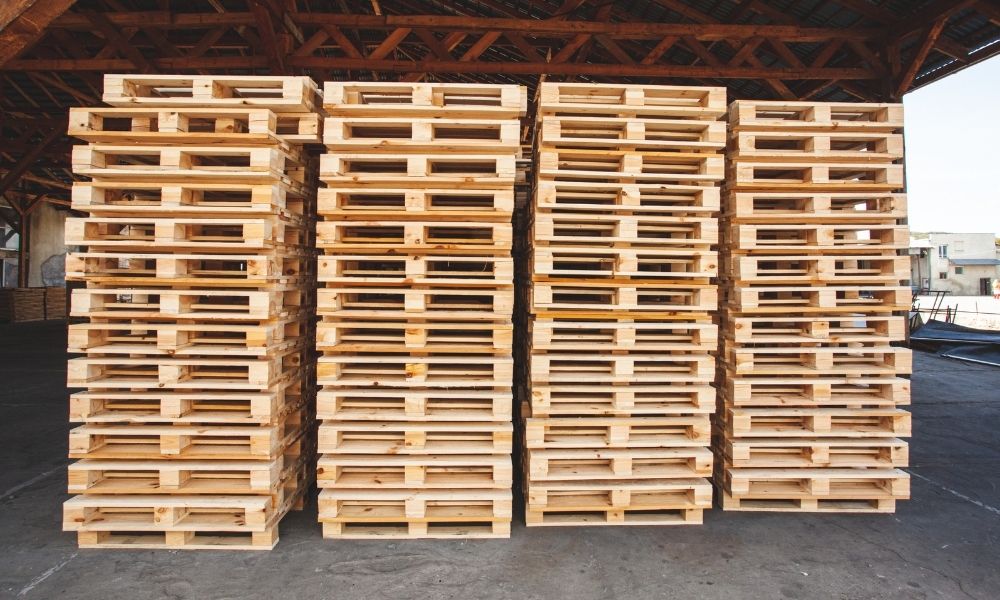Navigating your pallet management can be challenging. When you need pallets for your products and storage, staying within a reasonable budget is one of the most difficult tasks. This challenge is so common that many pallet users rely on pallet buy-back programs to obtain pallets without overblowing their budgets.
Pallet users also use a buy-back program to recycle and remove used pallets from their distribution centers.
However, not all buy-back programs are the same. Depending on the pallet supplier, pallet size, and pallet material type, the process of buying and selling pallets can differ drastically.
In this blog, we’ll examine which pallets are the best for buy-back programs. To learn more, continue reading the article below.
What Are Buy-Back Programs?
Before we delve into which pallets are the best for buy-back programs, it’s crucial that we outline what buy-back programs are and how they work.
When pallet users buy too many pallets or have used pallets, they can sell them to local pallet suppliers to earn money back. Even if a pallet user has a damaged pallet, these materials may also be sold for a profit to pallet recyclers.
Conversely, pallet users can also use buy-back programs to purchase recycled pallets at a discounted rate. These programs are essential for pallet suppliers and users at a lower price than buying newly manufactured pallets. They also keep the pallet supply chain moving.
Now that we’ve detailed the purpose and importance of buy-back programs, let’s examine which size and materials will be the best for earning money back in these programs.
The Most Ideal Pallet Size for Buy-Back Programs
Depending on the goods and products a business sells, sometimes pallet manufacturers create specific dimensions and customizations. However, while building and using custom pallets can be beneficial for a pallet user’s merchandise, these custom sizes aren’t always ideal for pallet buy-back programs.
The perfect-sized pallet for one business may not be as valuable or as versatile to other users on the market. However, users have other options: pallets can get custom-made and used ones can get remade. Custom-sized pallets often require additional labor, materials, and work to create.
The most valuable pallet size to sell through buy-back programs are rather GMA 48×40 pallets. This pallet size is one of the most uniform pallet sizes for a wide range of industries worldwide. Since so many businesses already use 48×40 pallets, the demand for this pallet size is considerably higher than custom pallets.
Pallet sellers are more likely to earn a higher rebate back, and pallet buyers will have a larger selection of recycled GMA pallets to choose from. Consider converting your custom-sized pallets to 48×40 GMA pallets to increase your earnings from future pallet buy-back programs.
The Best Pallet Materials for Buy-Back Programs
Since we’ve established that 48×40 GMA pallets are the best pallet size for buy-back programs, let’s examine how materials can affect used pallets’ pricing.
There are two main types of materials that manufacturers use to build pallets: lumber and plastic. Using wood and plastic pallets both come with their share of advantages and disadvantages. However, when it comes to buy-back programs, wooden pallets will be a more valuable material.
Since lumber is one of the most common materials manufacturers use to build pallets, many pallet-users prefer to use them. Many different industries also use plastic pallets; however, since wooden pallets have been in use longer, they remain the default material for pallets.
How Pallet Materials Affect Quality
The materials of pallets can also be a significant factor that affects their quality over time. When pallet users sell their pallets through buy-back programs, they’re compared to a grading system to designate their value. The pallet grading system groups different used pallets into different categories to indicate whether they’re a premium recycled grade pallet versus a standard A grade or standard B grade recycled pallet.
The Advantages of Wooden Pallets
Since wooden pallets can be reused and recycled several times before becoming too damaged for repairs, many pallet users benefit from using wooden pallets rather than plastic. Manufacturers can simply deconstruct and rebuild new pallets from older, reused pallet parts.
Wood pallet buy-backs can also be a significant alternative revenue stream. Manufacturers can break down and shred these older materials into mulch when pieces of older, used pallets are no longer salvable. Many businesses benefit from converting their damaged and broken pallets into this alternative revenue stream.
In comparison, plastic pallets cannot be repaired or resold once they sustain damage. Therefore, when pallet users damage plastic pallets, they have no other function.
The Advantages of Plastic Pallets
Plastic pallets come with their own set of advantages when they’re getting resold in a buy-back program. For example, plastic pallets are more durable than wooden pallets. While wooden pallets can hold heavier weight totals, plastic pallets are an ideal material for investing in when it comes to durability and longevity.
Therefore, plastic pallets will last longer, but wooden pallets will generate a higher resale value in most circumstances. When the value of pallets within the marketplace increases in general, then broken pallets are also more valuable and can be sold at higher rates.
The Takeaway
Many different factors affect the resale value of used pallets. Review this guide to examine how the size and materials of your pallets may affect their overall value in a buy-back program. Remember that 48×40 GMA pallets and wooden materials have some of the best advantages for receiving a fair resale price during buy-backs. To learn more about the pallet grading system and where your used pallets might rank, check out our pallet grade qualifications here.
If you want to learn more about buy-back programs, pallet specifications, and pallet management, consult us here at First Alliance Logistics Management. We offer top-tier pallet services to pallet users throughout the country. Whether you need assistance ordering new pallets or you’d like to improve your warehouse efficiency, we’ve got you covered.
Our team of experts has years of industry experience. If your current pallet management system needs repair, contact a member of our FALM team to learn more about how we can help. To learn more about the pallet industry and our solutions, check out our FALM website for more information.


